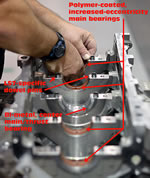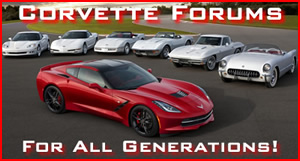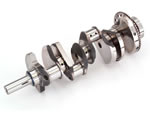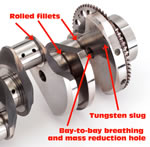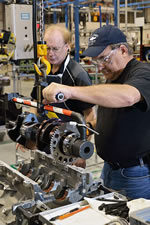Ruthless Pursuit of Power: The Mystique of the C6 Corvette LS7 Engine - Page 5 of 26
Ruthless Pursuit of Power: Lucky Seven Edition: The Mystique of the 7-Liter, 7000-RPM, LS7 - Page 5 of 26
 |
 |
by Hib Halverson
© May 2013— Updated: November 2014
No use without permission, All Rights Reserved
In its ruthless pursuit of power, GM didn't just haphazardly put holes in the main webs. In fact, early development LS7 cases did not have windows at all because, initially, GM couldn't produce a block with both bay-to-bay breathing windows and reliability at 500-horsepower. Extensive finite element analysis along with thrashing engines to death--in some cases, literally--on the dyno and in prototype Z's, eventually resulted in the LS7 block having both the necessary bay-to-bay breathing windows and more overall strength than any of its predecessors.
Besides 8-mm hone over travel radii, other changes were made to increase the block's reliability for use at the 500-hp level. First, the material used in the main bearing caps was upgraded from forged powdered metal to 1141 steel machined from forged billets. Secondly, each cap is located with by dowels making a more rigid structure once all six bolts are tightened. Some of Linamar's block machining processes are unique to the LS7, but the final two are noteworthy in that they came directly from racing. While they are standard procedure at places like Katech, they are rare for a production engine. First, all LS7 cases are align-bored with deck plates installed and the head bolts tightened to specification. Second, all LS7 blocks have their liners honed with the same deck plates installed and head bolts tight.
Once Linamar finishes LS7 blocks, they are cleaned and shipped to the Performance Build Center for assembly. We visited the "PBC". in the Winter of 2012 to assemble an LS7 (see: https://www.corvetteactioncenter.com/specs/c6/corvette-engine-build-experience/index.html) and while there, we learned there is no pre-assembly parts cleaning at the PBC. When Linamar cleans a block, they are spotless. Other suppliers are, also, required to furnish parts which are clean and ready for assembly. We asked Rob Nichols, the facility's Engineering Supervisor, how they ensure that. "We visually check all parts and if they are not to our liking, we send them back," Nichols told the CAC. "Periodically, we test-wash blocks and crankshafts. Any contaminants fall into a filter we place at the bottom of a wash basin," Nichols told the CAC. "The weight of these filters is pre-measured. We take the filters and sediment and bake them in an oven to dry out the filter and debris. Then, we reweigh the combination. The difference between the base weight and the weight of the filter with debris gives us the amount of sediment washed off of the parts. We have tolerances for the amount allowed. If it falls out of spec, we alert the supplier and (do further testing to) make sure all incoming product is conforming."
The LS7 was the first production engine to use "increased-eccentricity" main and connecting rod bearings. The term refers to the thickness of the bearing. Eccentric bearings get slightly less thick from the center to the edge where the split line relief starts. The difference in this thickness is the "eccentricity". Mark Damico, Design System Engineer--Small-Block Base Engine, who has worked on the Gen 3/4/5 engine program since 1993, told us that, prior to the LS7, bearings were either the same thickness from the center to edge or they had a very slight eccentricity. LS7 bearings have much more eccentricity, .0006-in for the number 1, 2, 4 and 5 mains and a whopping .0011-in for the rods. This higher level of eccentricity improved durability because bearings of this design flow more oil and are more tolerant of bearing bore distortion which increases with cylinder pressure. Use of high-eccentricity bearings eventually expanded to other Corvette engines, the LS9 in 2009 and LS3 dry-sump in 2010 and the Gen 5s in 2014.
If there's a downside of high-eccentricity bearings it's that clearance checking in the field is a little more complicated in that care must be taken to always check the clearance at about 90° to the bearing part line. Also, parts choices when bearings are replaced can be critical. If aftermarket bearings are chosen they must have a level of eccentricity that is similar to that of OE bearings because--if the bearings have less eccentricity--the engine will have either insufficient oil flow in bearings or--if the bearings have more eccentricity--insufficient oil pressure.
Until the 2012 model year, bearings of traditional, "tri-metal" (steel backing, bronze second layer and a top layer of lead) construction were used in the LS7's #1, 2, 4 and 5 main bearing positions and in the connecting rods. European Union legislation prohibits the import of products containing lead, so the main and con rod bearing designs were changed. Lead was replaced with a synthetic polymer making a "bi-metal-with-polymer" design. The center (#3) main bearing remains aluminum on a steel backing. According to Mark Damico, because of the firing order used on all Gen 3, 4 and 5 V8s, the second and fourth main bearings are subjected to the highest loads. After a long period in service, if an LS7's bearings are going to wear, it'll be the #2 and #4 mains which show it, first. The two end bearings may see a lesser level of wear due to (#1) the accessory drive or (#5) the flywheel. The center main experiences the least vertical load and while it is an increased-eccentricity design, it's never required a lead overlay nor polymer coating.
An LS7 part which I think is so pretty is the crankshaft. With its appealing brownish-coppery color and intricate finish machining--darn it--it's just too cool-looking to be in an engine. The eye candy that they are, LS7 cranks are trick parts for a production application being micro-alloy steel forgings manufactured by specialty supplier, SMI Crankshaft in Fostoria, Ohio. The cranks have some journals which are hollow for less mass and, in the case of mains, improved bay-to-bay breathing. All the journals have rolled fillets for increased durability and, like race engines, the front and rear counterweights are balanced with "heavy metal" slugs made of tungsten.
Early LS7 cranks were 4140 steel. Later LS7 cranks are 44MNSIVS steel. "The reason we switched," John Rydzewski told us, "was it eliminated one of the processes in fabricating it. With 4140, you have to quench and temper the crankshaft before final machining. With this new material, you don't have to quench and temper because (the steel) has a different grain structure. The end result is the same properties but (using the new material) eliminates a step reducing the cost of manufacturing."
 |
 |
